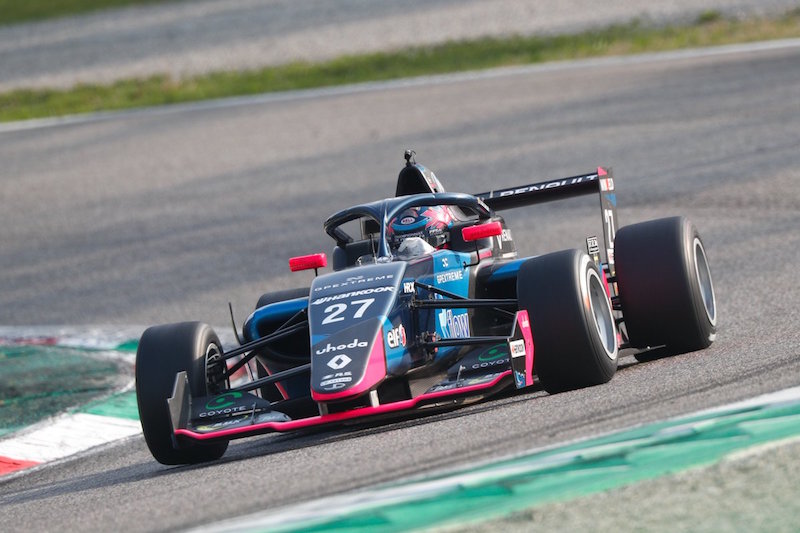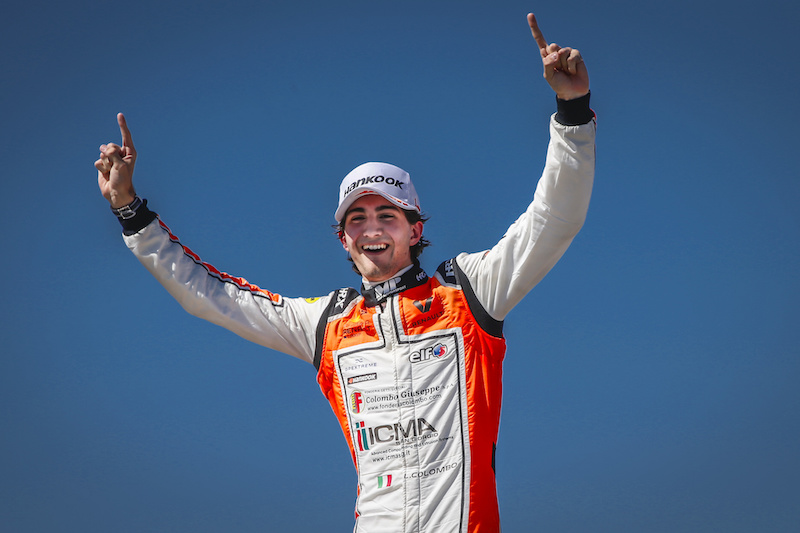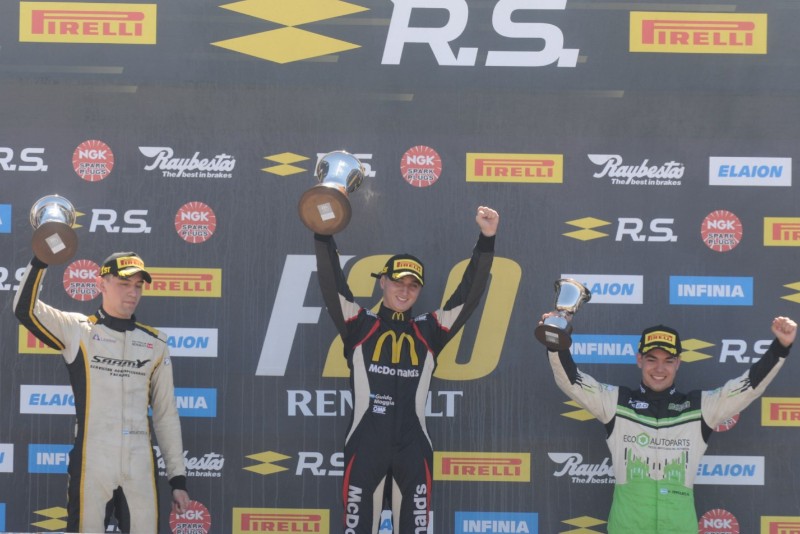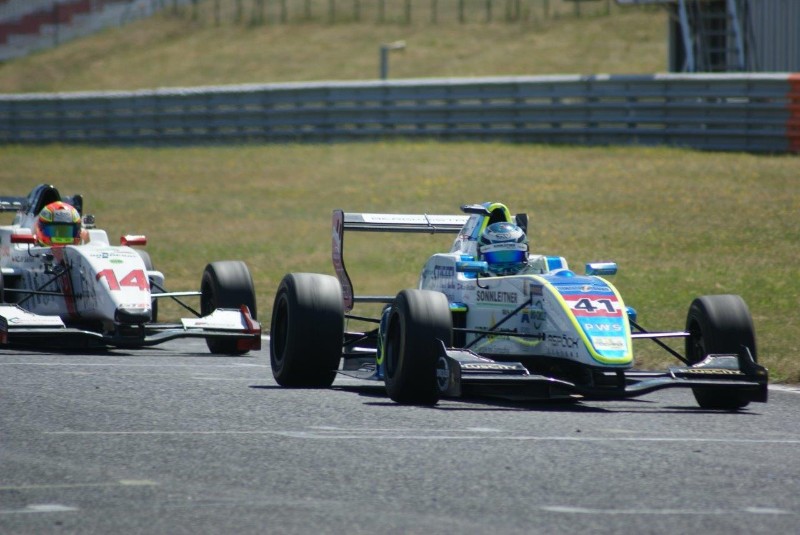
Photo: Renault Sport Series / Dutch Photo Agency
Renault’s halo series switched to Regional Formula 3 spec this year, but there were still series across the world utilising the manufacturer’s engine alongside some recognisable chassis to create great racing
It was the same name, most of the same circuits and teams, but a completely new-look Formula Renault Eurocup this year.
Josef Kaufmann Racing and Tech 1 Racing, AV Formula and Fortec Motorsports left at the end of 2018, as did the Tatuus FR2.0/13 car, with Bhaitech, FA Racing by Drivex, Global Racing Service, M2 Competition and the Tatuus T-318 replacing them.
The larger, heavier car wasn’t particularly popular at the start of the season, especially after late deliveries meant there was a very limited pre-season for all teams, and there were calls for “an extra 30bhp” to the existing 270bhp three rounds in due to the effect the car’s weight had on steering.
Teams were impressed by the new brakes, taken from 2017 GP3 cars, as well as the extra freedom when it came to making aerodynamic and suspension changes, although there was obviously no carryover of set-up expertise from the previous car.
The season began at Monza, with 16-year-old Ugo de Wilde leading Renault F1 affiliate Leonardo Lorandi in a JD Motorsport one-two. It was the team’s first win since 2006, and de Wilde became just the fifth Eurocup debutant winner this century.
R-ace GP’s Alexander Smolyar won from pole in the wet second race, which was riddled with crashes. Two podiums put Renault junior Victor Martins in the lead of the standings, with eventual champion Oscar Piastri down in seventh.

Set-up was very much a guessing game early on, and it was R-ace that got it right at Silverstone. Piastri topped free practice and was first place in both qualifying sessions and races for the team, and moved into the championship lead in the process.
Smolyar actually led the first race before a technical problem, leaving Piastri 12.693 seconds in the clear. Their rookie team-mate Caio Collet, another Renault junior, also benefited from R-ace’s pace to take two top-five finishes.
Fast but struggling was Drivex’s Callan O’Keeffe, who finished eighth twice. He was eighth and ninth in the next round at Monaco, but lost his drive not long after. His contribution to the team’s points tally equated to 93.3%.
Martins and Smolyar shared the poles and predictably won in Monaco, which propelled the pair back past Piastri in the points.
MP Motorsport keyed the new car in best at Paul Ricard, where Lorenzo Colombo ended his long wait for a first win, then followed it up with another in a weekend where he was untouchable. There was no change in the standings, but Piastri put in a crucial title-worthy performance by battling from 17th to sixth in race two.
Piastri was not the best qualifier – he took five poles to Martins’ nine – but his aggressive but clean racecraft meant he always scored highly. This was evident at Spa-Francorchamps, where he controlled race one from third on the grid, and wiled his way from eighth to third in race two before a red flag reclassified him fourth. In both races he was outqualified by but beat Martins.
Another Spa star was Sebastian Fernandez, who made the podium despite stalling. This was the start of a rise for Arden, with Fernandez’s stand-in Alex Quinn taking two podiums in six races and Patrik Pasma finishing second at the Nurburgring.

It took some patience from Piastri before the Australian could pass Pasma to win there, but he followed it up with a crushing 14.823s win and a championship lead of 40 points in the space of two races.
This was partly down to Martins not starting the second Nurburgring race due to a technical issue on the warm-up lap, which was equalled out by Piastri spinning off in the wet on the warm-up lap of the next race at the Hungaroring.
Martins took a comfortable victory in his absence, albeit one counting for half-points as the race ended after three laps. Piastri bounced back by heading Smolyar and Martins in race two, and leaving Germany with a 37.5-point lead.
Martins kept his head down and scored six poles in a row, the first three of which became wins. After a lap one spin sent him to last, Piastri climbed to fifth in Barcelona race one, and he came behind a dominant Martins and Bhaitech’s Petr Ptacek in race two.
In wet conditions Martins took another win at Hockenheim, and after being passed by Smolyar looked to follow it up with a second place and another slashing of Piastri’s points lead. In the final two minutes he clashed with Collet, who was having his most competitive showing of the season, and finished in sixth. Piastri took second and a 13.5-point lead to Abu Dhabi.
The heat was literally on at Yas Marina Circuit, and Martins was a step up above in every session bar the floodlit first race.
His start and first lap was poor, and it required five laps and team orders from MP for him to pass team-mate Colombo for second place. Once he was in second place he seemed to get his head in shape, but with Piastri in the lead it was still a wasted race. According to Piastri, his own start had been poor, and it bit him from the front row in the title decider.

Photo: Renault Sport Series
This time Martins controlled the race from the front, with Piastri being shuffled down from second to fourth at the beginning. Martins claimed Piastri’s difficult opening lap was in part down to his tactic of slowing down the field at the front, but regardless of if it was it didn’t prevent Piastri from being crowned champion.
Formula Scout’s Top 5 Eurocup drivers
Key Percentage of team’s points scored (TP), Average qualifying position (QA), Average race points position (AP)
5. Alex Quinn BRITAIN Arden
12th in standings, 48 points (2 podiums) – TP 25%, QA 4.8, AP 8.0
In just six races mid-season, Quinn showed what he and Arden were capable of and had a scoring rate better than anyone outside of R-ace and MP. Every circuit was new to the 18-year-old, whose only experience outside of driving and then coaching in British F4 includes a 2017 BRDC British F3 cameo and some British GT4 races last year. A 2020 return would be tantalising.
4. Lorenzo Colombo ITALY MP Motorsport
4th in standings, 214.5 points (3 wins, 3 poles, 2 fastest laps, 7 podiums) – TP 40%, QA 5.2, AP 10.7
A promising rookie season with JD Motorsport was followed by… a promising season with MP Motorsport. Beyond his sublime Paul Ricard weekend, Colombo was usually the third or fourth best driver in the field but he was consistently mistake-free. He took a deserving third win at Spa, but still struggled on his weak circuits from last year.
 3. Alexander Smolyar RUSSIA R-ace GP
3. Alexander Smolyar RUSSIA R-ace GP
3rd in standings, 255 points (3 wins, 2 poles, 4 fastest laps, 10 podiums) – TP 40%, QA 5.1, AP 12.8
SMP Racing protege Smolyar had it in him to be quickest on the grid at most circuits, and so it’s a surprise he didn’t win more than thrice. His tally of six second places, and scoring only one podium less than team-mate Piastri, shows how much he was at the front, and were it not for his Silverstone retirement he would have been in title contention until the penultimate race.
2. Victor Martins FRANCE MP Motorsport
2nd in standings, 312.5 points (6 wins, 9 poles, 5 fastest laps, 14 podiums) – TP 59%, QA 2.8, AP 16.4
The title so easily could have gone Martins’ way, and so closely matched were MP and R-ace that it was refreshingly easy to draw comparisons with Piastri. Martins usually had the upper hand in qualifying, and despite being as error-prone as his rival, Martins’ bad days were more costly. Not making more of MP’s pace advantage at Paul Ricard was also a potential title loser.
1. Oscar Piastri AUSTRALIA R-ace GP
1st in standings, 320 points (7 wins, 5 poles, 6 fastest laps, 11 podiums) – TP 50%, QA 3.3, AP 16.8
Switching from Arden to R-ace for his second season was what Piastri needed to show off his talent, and his tally of seven wins was last bettered in 2010. He and Martins were very close, and one distinguishing factor was Piastri’s ability to score strong points from any situation, no matter where he started on the grid. Unlike Martins, he could win when not on pole.

Photo: Renault Sport Series
Ultimate Cup Series
Taking over from VdeV Single-Seater Challenge and also filling in the gap in the European Formula Renault 2.0 market following the restyling of the Eurocup and demise of the Northern European Cup, the newly launched Ultimate Cup Series Single-Seater Challenge proved to be a underground success.
VdeV – a club-focused championship – launched the careers of FIA F3 Championship’s Alex Peroni and BRDC British F3 race-winner Nico Varrone, and in years gone by was a a valuable learning ground for drivers wanting to enter the more competitive FR2.0 series. UCS followed the same model for its foundation year, and raced in five countries.
Former GP3 driver Amaury Bonduel, still only 20, and 17-year-old French F4 graduate Sacha Lehmann engaged in a season-long title battle at Lamo Racing, one of the long-serving VdeV teams that switched allegiances pre-season.
Lehmann took pole for the first two races of the Estoril season opener, but ended up slipping to fourth twice. TS Corse’s Brice Morabito pipped Bonduel to success by 0.046s in race one, with Bonduel returning the favour by a bigger margin in race two. He also won the third race, but this time Lehmann’s learned from his mistakes and finished second.
Bonduel converted a 0.059s qualifying advantage into a 0.265s win over Lehmann in race one at Dijon, which Lehmann responded to in race two with a 0.093s win from pole, and with the third placed driver over half a minute behind. Lehmann started race three from pole as a result, but got beaten by Bonduel once again.

Photo: Hugues Laroche / UCS
Their team-mate Augustin Collinot was fastest in qualifying at the Slovakiaring, but it was Bonduel and Lehmann who ended up on top of the podium, with two wins for the latter.
CD Sport’s Baptiste Berthelot, another French F4 graduate, set the pace at Mugello. He took a double pole and turned the first into a dominant win, with Lehmann and Bonduel fourth and eighth in the 20-car field. Both had reason to smile the next day, as Lehmann passed and fended off Berthelot to win race two, and Bonduel overtook four cars in a lap to win race three.
Bonduel took an easy triple win at Valencia Ricardo Tormo, where Collinot was twice his closest rival. Lehmann was back on the pace at the more familiar Magny-Cours, but lost further points when he retired on the opening lap of race one, which Bonduel won. He struck back to win race two, but was then lapped by winner Collinot in race three.
The wet Paul Ricard season finale also went Bonduel’s way as he took three more wins, and beat Lehmann to the title by five points. Collinot made it a Lamo 1-2-3 in the points, ahead of Berthelot and TS Corse’s former FR NEC driver Pietro Peccenini.
Argentinian FR2.0
Once again, the Argentinian title ended in blockbuster style. Two years ago, the champion was crowned in court after the contenders collided in the title decider and were excluded from the meeting. This time, the top two were matched on points.
Croizet Racing’s Esteban Fernandez was often the fastest driver on track, but he won infrequently and it was LR Team’s teenager Guido Moggia and Gabriel Werner Competition’s Mateo Polvakovich that were the consistent scorers.

Fernandez still went into the 12th and final round of the season at Neuquen in title contention, alongside Moggia, Polvakovich and Litoral Group’s Tobias Martinez.
Moggia was fastest in the red flag-interrupted qualifying, and worked his way to the front of the reversed-grid first race. Second place for Polakovich put him in the points lead ahead of Moggia, with Martinez dropping to third after retiring.
Nobody had an answer for Moggia’s pace in race two, with his team-mate and winner of the season opener Facundo Marques acting as a useful early buffer. His opposition mostly had a disastrous time, with Fernandez encountering problems on the way to the grid that prevented him from starting the race, and Martinez immediately dropping places at the start.
Polakovich soon passed Marques for second, but without being able to close in on Moggia’s lead he saw his five-point lead reduced to nothing. As a result, it came down to which of the pair had won more races, and Moggia’s tally of five meant he was crowned champion. He follows his brother Martin, who is also sponsored by McDonalds and won the 2015 title.
Formula Nordic
The North European Zone-based series, where FIA European F3 race-winner Ralf Aron and BRDC British F3 champion Linus Lundqvist started their careers, was uncertain racing would take place this year as the Scandinavian touring car championship it shared a paddock with and was promoted by went bankrupt. The teams involved set up their own association and relaunched the championship, using the same FR1.6 cars as before and with a modest grid of seven drivers.

Changing weather hit the first race weekend at Ring Knutstorp, and it was Team Greenpower’s Edward Sander Woldseth who took the first win of the season despite excessive tyre wear. MA:GP’s Victor Andersson won the series’ first ever reversed grid race the next day from sixth on the grid.
Woldseth won again at Rudskogen Motorpark, where there was drama in the reversed grid race. Gabriel Nord and Woldseth clashed while disputing the lead, and while Nord did win he was then penalised and victory was handed to William Winsth.
Greenpower’s Magnus Gustaven and Winsth won at Anderstorp, with the latter then becoming the first single-seater winner at the new Drivecenter Arena circuit. Woldseth won race two, and Andersson took the points lead by winning race three. At Karlskoga, Woldseth was denied a triple win by reversed grid poleman Nord.
The grid grew on the series’ second visit to Norway in September, and Woldseth was narrowly denied multiple wins once again. He lost race two by 0.092s to Andersson, and was pipped by Winsth in soaking conditions in race three.
Bad weather continued into the return trip to Karlskoga, where Woldseth consolidated a points lead with another two wins. Charlie Andersen came out on top in a exciting final race, where tyre strategy split the field.
The season ended at Mantorp Park, where victory for Andersson in the opening race secured him the Junior title and Woldseth the overall NEZ crown. Greenpower’s Havard Hallerud won the final race.
Despite the small grid size, the series proved domestically popular and is set for a stronger 2020 despite nearby rival series.
Austrian FR2.0 Cup
Left-field F3 series Austrian F3 Cup has its own even lesser-known FR2.0 class, and this year it was won by BRSCC National Formula Ford 1600 graduate Nico Gruber – who told Formula Scout that his career ambition is to race in the Austrian F3 Cup.
The Team Hoffmann Racing driver was short on competition, with half-points being awarded when the grid had less than five cars. He won 12 of the 15 races, with team-mate Dr Norbert Groer, an international vet, taking two second places to finish runner-up in the standings. Kart Republic karter and Team HKC Racing driver Matej Kacovsky won at Imola to come third in the points, ahead of the third Hoffmann car of Simon Stoller, who won both races of the Monza season opener.
Further reading
Joey Alders ends Asian Formula Renault title year at Zhuhai (December)
The underfunded Techeetah beater who had to reset his career (November)
The face behind R-ace GP: Formula Renault’s latest title winner (June)
The patience behind Nyck de Vries’ long road to the F2 title fight (June)
Scout Report: Alexander Smolyar (April)
The question marks over each series in the big European F3 shake-up (April)
